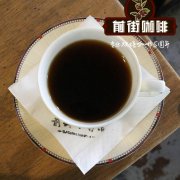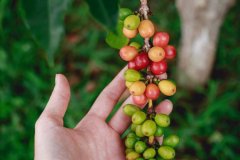What are the characteristics of Red Cherry Project Coffee? Is Ye Jia Xuefei the Red Cherry Project?

Professional coffee knowledge exchange more coffee bean information please follow the coffee workshop (Wechat official account cafe_style)
What is the red cherry project?
The Red Cherry Project (Operation Cherry Red Project) is a project aimed at improving the quality and value of raw beans of Ethiopian coffee. Since 2007, initiated by Dutch trader Trabocca and farmers from producing areas, 100% ripe red coffee cherries will be harvested by hand at the beginning of the harvest season, indicating that each coffee seed is ripe and nutrient-rich. In the next few years, the Red Cherry project has successively purchased facilities such as sun scaffolding, cherry peeling machine, coffee bean sorting machine, and cup testing laboratory for the producing area, so the coffee beans of the current Red Cherry project are already a guarantee of high quality.
SCFCU is a large coffee cooperative federation in Ethiopia, with about 46 member cooperatives. The whole alliance is made up of more than 82000 farmers, the second largest coffee cooperative alliance.
The Red Cherry Project (Operation Cherry Red) is led by the Dutch company Trabocca, and half of the funding is sponsored by the Dutch government. Since 2005, it has worked with many small coffee cooperatives to encourage and assist producers to do their best to improve the quality of coffee by improving washing, semi-washing, tanning or other experimental treatments. Every time before the harvest season, Trabocca invites selected smallholder organizations / producers to participate in the production of micro-batches of coffee (about 1500 to 3000 kg), carefully picking 100% ripe red coffee cherries by hand (hence the Red Cherry Project).
Trabocca provides financial, equipment and technical resources to assist farmers and promises to buy them at a good price as long as the quality of the actual output meets high standards. Therefore, the Red Cherry Project is not only a commercial activity in line with the Fair Trade regulations, but also a production activity for producing high-quality coffee, but also an industrial structure reform activity to simultaneously enhance the interests of farmers and consumers.
The red cherry project is also a reinforcing method, which makes the farm pay more attention to the process of selecting beans. The prices of these coffees are also relatively high. Red cherries plan to have water washing, sun-drying beans, half-washing, half-sun, experimental coffee and so on. The main producing areas are Yegashev, Sidamo, Penga Forest, Lekanti, Kembata, Iruba, Hara, Lim, and joined Coroja Golocha in 2011 (near Hara). These are unique flavors and can fully show the flavor of Ethiopian beans. Trabocca will choose from the coffee after receiving it. Farms that have passed the cup test quality test in Ethiopia and the Netherlands will pay a high bonus, and the cup test pass score must be more than 88 points in order to become a good coffee for the Red Cherry project. Trabocca, the promoter of the Red Cherry project, invested all the profits earned in the past few years in the cooperative farm. Trabocca stressed that this is an unprofitable plan, so the company only uses four people, including the boss and secretary, to carry out the Red Cherry project, and other administrative related matters are supported by the parent company to reduce administrative expenses, and all the profits are returned to the cooperative farm.
Aroma aroma / flavor flavor: strawberry, nut, biscuit, fermented flavor, grape, mango, banana, vanilla, chrysanthemum tea, black tea ripe tea, chocolate, honey
Acid quality: plum, grape, sweet orange, red apple acid, low acid quality, single malt tartaric acid
The complexity of complex is similar to that of other: complex and multi-layered, very clean and fresh, lively and flexible, heavy taste after cooling, obvious flavor of fermented brandy and long-lasting finish.
The recommended brewing parameters of Qianjie coffee:
V60BX 89-91 ℃ / powder-water ratio 1: 15 / extraction time: 50 minutes
Important Notice :
前街咖啡 FrontStreet Coffee has moved to new addredd:
FrontStreet Coffee Address: 315,Donghua East Road,GuangZhou
Tel:020 38364473
- Prev

What is the roasting degree of Guatemala Vivette South Fruit Coffee? Where did the name Guatemala come from?
Professional coffee knowledge exchange more coffee bean information please follow Coffee Workshop (Wechat official account cafe_style) Guadi is a nickname for Guatemala. The Mayan town sits on top of 37 volcanoes, two of which erupted in 2010. Coupled with frequent tornadoes and natural disasters everywhere, it is truly dangerous.
- Next

Introduction to the origin of Panamanian geisha coffee Jhala Miyou Manor _ location and variety of Panamanian boutique coffee
Professional coffee knowledge exchange more coffee bean information please follow the coffee workshop (Wechat official account cafe_style) [Coffee producing Tour] Panamanian coffee is not only an international strategic competition, but also the overlord of boutique geisha coffee actually, as early as 2004 AD, Panamanian coffee has always been a marginal country of boutique coffee, has not been valued by the international coffee community, however, in the
Related
- Detailed explanation of Jadeite planting Land in Panamanian Jadeite Manor introduction to the grading system of Jadeite competitive bidding, Red bid, Green bid and Rose Summer
- Story of Coffee planting in Brenka region of Costa Rica Stonehenge Manor anaerobic heavy honey treatment of flavor mouth
- What's on the barrel of Blue Mountain Coffee beans?
- Can American coffee also pull flowers? How to use hot American style to pull out a good-looking pattern?
- Can you make a cold extract with coffee beans? What is the right proportion for cold-extracted coffee formula?
- Indonesian PWN Gold Mandrine Coffee Origin Features Flavor How to Chong? Mandolin coffee is American.
- A brief introduction to the flavor characteristics of Brazilian yellow bourbon coffee beans
- What is the effect of different water quality on the flavor of cold-extracted coffee? What kind of water is best for brewing coffee?
- Why do you think of Rose Summer whenever you mention Panamanian coffee?
- Introduction to the characteristics of authentic blue mountain coffee bean producing areas? What is the CIB Coffee Authority in Jamaica?

